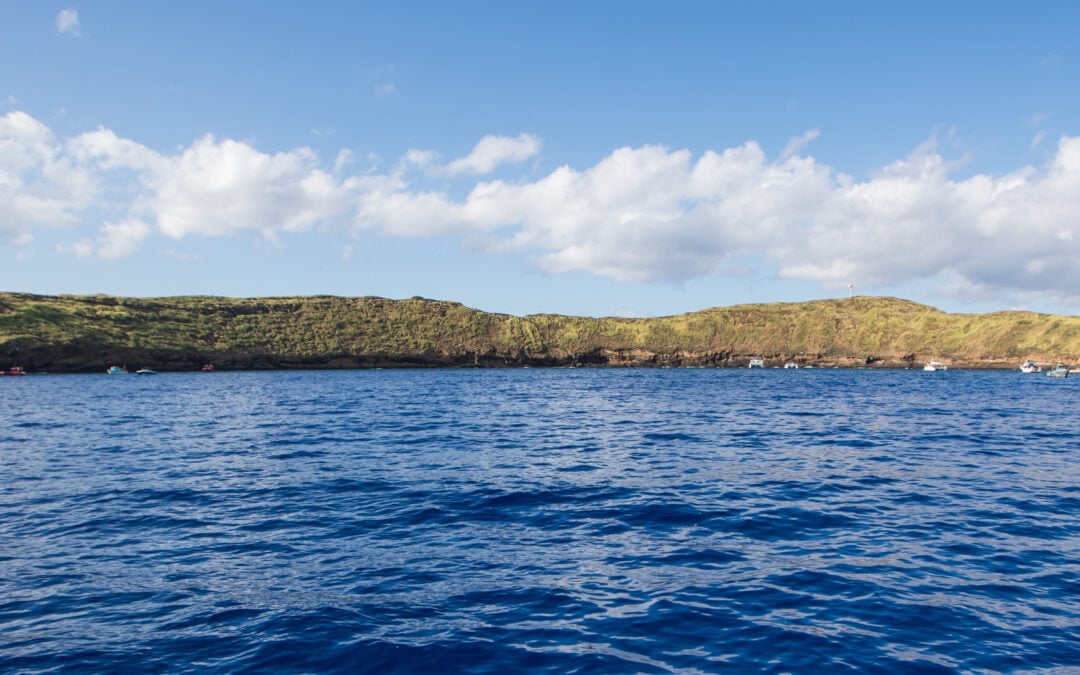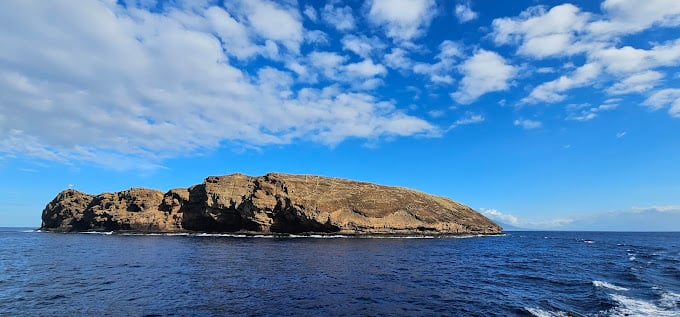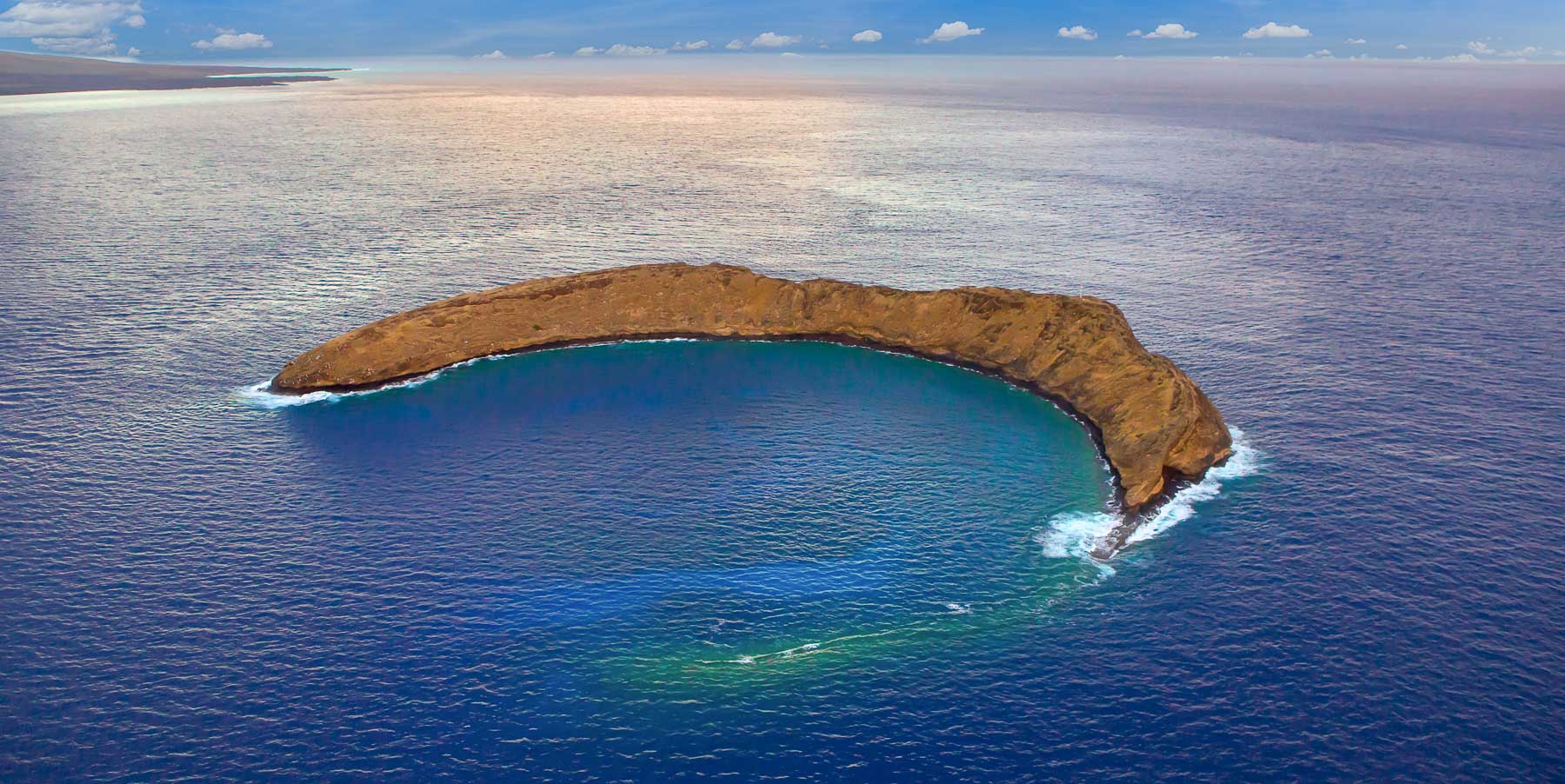Molokini Crater Hawaii is a crescent-shaped, partially submerged volcanic crater located off the southern coast of Maui. This unique geological feature is a popular tourist spot. It has a rich history, both in geology and culture. Plus, it’s a protected seabird sanctuary and marine reserve.
Continue reading to dive deeper into Molokini Crater, Hawaii’s history and conservation. Discover more about our Maui Snorkeling tours that take you to this iconic destination. Join us for a morning trip, or choose an afternoon outing. Our Maui snorkeling tours guarantee an unforgettable adventure!
Learn More: Molokini Snorkeling
Geological History
Molokini Crater is believed to have formed about 230,000 years ago through volcanic activity. It’s the result of an eruption that occurred when magma rising from the Earth’s mantle reached the water’s surface and caused a violent steam explosion. This type of volcanic activity is known as a phreatomagmatic eruption.
Archaeological findings, including stone sinkers and lures, indicate that early Hawaiians frequented Molokini for fishing. They likely also collected seabirds, eggs, and feathers from the area.
The crater covers 23 acres. At its highest point, it rises about 161 feet above sea level. At its deepest, it dips down to about 300 feet below the water’s surface.
Photo courtesy of Wikipedia
Cultural History
Historically, Molokini Crater in Hawaii was important to ancient Hawaiians. It served mainly as a valuable fishing spot. The islet, which was part of the Honuaula District of Maui, was highly regarded for its rich marine ecosystem. The rich marine life in Molokini makes it a great spot for fishing. Hawaiians from nearby areas often come here to cast their lines and nets.
Despite its utility, there is no evidence to suggest that Molokini ever hosted permanent settlements. Its small size and the rocky nature of its terrain likely made it unsuitable for long-term habitation. Instead, it seems that Molokini was used sporadically as a day trip destination where people could exploit its bountiful fishing opportunities and perhaps collect other marine resources during their visits.
The absence of permanent settlements does not diminish Molokini’s historical importance as a resource hub. The islet helped support the simple lifestyle of ancient Hawaiians. This shows its importance in the culture and economy of Hawaii before contact with outsiders.
Mythology
The name “Molokini” is steeped in Hawaiian mythology, reflecting the islands’ rich cultural heritage. Legend says that Molokini was a beautiful woman who got caught in a love triangle with Pele, the fierce goddess of fire and volcanoes. Both women were in love with the same prince, which ignited Pele’s jealousy.
In a fit of rage, Pele sliced Molokini in two, turning her into stone. The remains of Molokini became the crescent-shaped crater we see today. The story suggests that Pu’u’ Olai, a cinder cone by Makena Beach, is the severed head of Molokini. This legend captures passion, rivalry, and transformation themes, enriching the mystical aura surrounding Molokini Crater.
Molokini Crater Hawaii Tours
Come along on our Maui Snorkeling Tours to Molokini Crater! Enjoy fun for the whole family in crystal-clear waters!
Military History
During World War II, the U.S. military used Molokini Crater as a target practice site. The use of the islet was clever because of its remote location and target-like structure. However, it caused severe damage to the crater’s natural landscape. The military activities disrupted the marine habitat and left behind remnants that would pose risks for years to come.
As the war ended, the focus shifted from military utility to conservation. The clear damage done to Molokini during the war raised awareness among environmentalists, scientists, and locals. They became more concerned about protecting and preserving this unique natural resource. This shift in thinking was part of a bigger movement for environmental conservation. It was growing in Hawaii and across the United States.
The post-war years saw increased efforts to safeguard the crater’s marine and terrestrial ecosystems. The increasing understanding of ecological balance and the importance of biodiversity bolstered these efforts. So, efforts to clean up leftover military waste and manage human activities in the area more sustainably got support. This resulted in protection. These protections aimed to repair the damage. They also help keep Molokini’s ecological, cultural, and historical significance safe for the future.
Photo Courtesy of MolokiniCrater.com
Conservation and Tourism
In 1977, Hawaii created the Molokini Shoal Marine Life Conservation District. This was to protect its special marine environment. This significant conservation effort introduced stringent regulations on fishing, anchoring, and the removal of marine life, including the once-overharvested beautiful black coral.
Black coral was extensively harvested from the 1950s until 1977, leading to significant ecological impacts. Today, activities like trolling and removing native species are only allowed from the crater’s outer rim. This area extends out to 100 yards.
In the crater’s beautiful inner reef, we focus on gentle activities like snorkeling, scuba diving, and snuba. These options let visitors enjoy the reef’s beauty while protecting its delicate ecosystem. These regulations ensure that the inner reef remains a pristine sanctuary for marine life.
Reputable institutions such as the Hawai’i Institute of Marine Biology, the University of Hawai’i Marine Options Program, and the Division of Aquatic Resources closely monitor the reef’s health and vitality. The ongoing conservation efforts are crucial for maintaining the reef’s ecological balance, not just its aesthetic appeal.
Molokini Crater in Hawaii is home to a stunning variety of marine life. You can find around 250 species of fish, 38 kinds of hard coral, and 100 species of algae. Among the vibrant marine life you can encounter at Molokini are Yellow Tang, Parrotfish, Butterflyfish, Moorish Idol, and the colorful Humuhumunukunukuapua’a, Hawaii’s state fish. These vibrant ecosystems are carefully protected, ensuring that Molokini remains a safe home for many marine creatures. It plays a vital role in Hawaii’s aquatic biodiversity.
Today, Molokini is a State Marine Life and Bird Conservation District. It’s famous for its clear waters, with visibility reaching up to 150 feet on a good day. This makes it a top spot for snorkeling, scuba diving, and snuba diving. The crescent shape of Molokini acts like a natural barrier. It shields you from waves and strong currents in the channel. This creates great conditions for snorkeling, especially in the early morning. Our Maui Snorkeling Morning Tour leaves at 7 am. This timing is great for enjoying the calm waters for Molokini snorkeling
Molokini is a key part of Maui’s natural heritage. It showcases Hawaii’s unique ecosystem and stunning geology. Management and preservation efforts help keep it a great place to see marine life and conduct scientific research.
Mooring at Molokini Crater is carefully regulated to protect its unique and delicate marine ecosystems while ensuring a sustainable visitor experience. To minimize damage to the coral reefs, the State of Hawaii has established specific mooring locations around the crater.
These special moorings prevent boats from dropping anchors on the reef, protecting the underwater habitat from damage. Both commercial and recreational boats need permits to use these moorings. This helps control the number of visitors and reduces environmental impact.
The regulations include limits on when boats can moor at Molokini and how long they can remain. These steps help marine life rest and lower the impact of tourism on the environment. Using a fixed mooring system helps protect coral reefs. This supports the many different species that live there.
This approach protects the environment and enhances the quality of the visitor experience. Tourists can enjoy clearer waters and fewer crowds. This allows for more personal and rewarding experiences with the vibrant marine life of Molokini Crater. The managed mooring system exemplifies how thoughtful regulations can balance human activity with environmental preservation, making Molokini a model for sustainable marine tourism.
Maui Snorkeling Tours
Our Molokini Crater Snorkeling Tour offers an exciting underwater adventure. It runs every day from 7 AM to 12 PM. We explore two premier snorkeling destinations to ensure a memorable experience.
We start our adventure at the famous Molokini Crater. Known worldwide for its colorful marine life and clear waters, snorkeling here is truly amazing! Next, our tour takes you to Turtle Town. You can swim with the gentle Hawaiian green sea turtles in their natural home. As we explore these amazing spots, watch for Humpback Whales swimming through the Hawaiian waters. You won’t want to miss this!
Just a heads up! While we love starting at Molokini Crater, our snorkeling spots may change due to the weather. This helps keep everyone safe and happy.
We’ve made changes to honor the Department of Land and Natural Resources’ request. Our Maui Snorkeling Afternoon Tour now focuses on Coral Gardens or Turtle Town. This change helps keep the noise down at Molokini Crater.
This tour runs from 1 – 4 pm daily and is perfect for those looking for a more relaxed and less crowded snorkeling adventure. Most afternoons, our guests love snorkeling and sliding at Coral Gardens or Turtle Town. On special occasions, we offer a snorkeling-only experience at Molokini Crater. This option lets you explore its beautiful marine life in a calm setting, without the waterslide.
Our family-friendly snorkeling tours welcome little adventurers—kids under 4 join for FREE! We offer an all-inclusive experience, ensuring that everything you need is provided. From top-notch snorkeling gear and optical masks to onboard training for all ages, we’ve got you covered. Enjoy additional fun with boogie boards!
Your day will include a tasty deli lunch. You’ll also enjoy coffee, tea, juices, and soft drinks to refresh you during the adventure. Dive into a worry-free day where fun and relaxation are the only items on your itinerary!
Maui Snorkeling Tours
Come aboard our morning tour to Molokini Crater! Dive into a world of tropical fish and explore the stunning coral reef!
The Future of Molokini Crater Hawaii
The future of Molokini Crater Hawaii involves a continuing emphasis on balancing tourism and conservation to preserve its unique ecological and geological characteristics. As one of Hawaii’s top snorkeling and diving destinations, managing human impact on this delicate marine environment is critical. Here are some key aspects that are likely to shape the future of Molokini Crater:
- Continued Conservation Efforts – Conservation will remain a priority to ensure the sustainability of Molokini’s marine ecosystems. Efforts might include stricter rules on visitor numbers, allowed activities, and enforcing current fishing and boating regulations. Ongoing scientific research will be important for guiding conservation efforts. It helps us understand the reef’s long-term health and its creatures.
- Climate Change Impact – Like many ocean areas worldwide, Molokini Crater must adapt to the effects of climate change. Rising sea temperatures, ocean acidification, and changing marine life patterns could affect the biodiversity and structural integrity of the crater’s coral reefs. Management strategies should be flexible and proactive to reduce these effects. This may include coral restoration projects and other marine management practices.
- Education and Community Involvement – Enhancing educational programs and involving the local community in conservation efforts are likely to be crucial components of preserving Molokini. Increasing awareness about the ecological value and vulnerabilities of Molokini can encourage responsible tourism and local stewardship. Educational programs can highlight Molokini’s value as a natural resource and its cultural significance for Hawaii.
- Regulation and Monitoring – As tourism continues to grow, there may be increased monitoring and regulation to ensure that activities around Molokini are sustainable. This could mean better tracking of the ecosystem’s health. It also involves using real-time data to manage visitor numbers and activities effectively.
As we think about Molokini Crater, we see its journey from a volcano to a cherished marine sanctuary. This special place has a fascinating past and a bright future ahead. The effort to balance preservation and tourism shows a real dedication. It helps keep the crater’s beauty and wildlife safe for future generations. Looking ahead, with ongoing conservation initiatives and increased community involvement, Molokini will continue to thrive as one of Hawaii’s most treasured destinations. Snorkeling in the colorful coral reefs of Molokini Crater, Hawaii, is an unforgettable experience. You can enjoy stunning views while connecting with nature. This beautiful spot reminds us why we need to protect our precious marine treasures.





